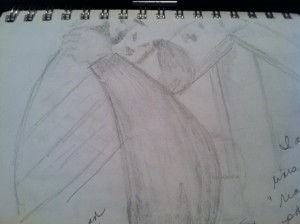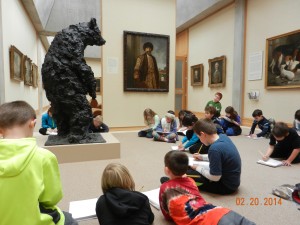Sketching time is the planning piece of writers’ workshop. There is no talking. I prefer it to be silent, but many people (students and adults) enjoy soft music in the background. The idea is to have an environment where you can concentrate on the drawing and listen to your thoughts as you sketch.
When it is quiet, it is easier to do, especially in schools where there is so much activity right outside the classroom door and students are in close proximity to each other. But, as you might have noticed in the movie trailer, when the children sketch, they are totally engaged; observing, making marks and thinking.
The galleries in the museum are ideal places to sketch. The atmosphere in the museum encourages thought and quiet reflection despite the fact that the museum is a public place with visitors constantly walking by.
Some people mentioned yesterday, they got lost in their thoughts as they sketched and didn’t hear any of the sounds around them in the galleries.
Your students will feel the same when you bring them to visit.
I am always amazed at the memories and ideas that come to the surface when I am in the process of sketching.
Ask yourself. When you sketched in the galleries, were you reminded of someone or an event you hadn’t thought of in some time? Or did an idea occur to you that you hadn’t planned on?
I noticed with the group that when it was time to stop sketching and begin writing, there was no hesitation. Everyone had something to say and put pencil to paper immediately. No “writer’s block” seemed present.
How did that feel?
How did sketching help you begin writing?
Did you feel less pressure to produce writing?
How did you feel having invitations versus and assignment to writing?
How would your students react to this process?
Sketches serve several purposes in the classroom. With younger students, I post a sketching rubric as a reminder of expectations and to eliminate the requests for new paper and do-overs. I want them to work out the changes on the original piece. Don’t discard ideas, just put them aside. The sketch is not meant to “go with” the writing, it is more a collection agency of ideas and details that will be used for reference as they write.
I encourage students to keep their sketches on hand as they write. When they get stuck in writing the first thing I say is, “Go back to the sketch, add something, change something. “ This is the beginning of revision, even if they add shading or introduce a new color or object to the sketch. It will bring them back to the writing.
As I conference with students, the sketch is the first thing I read. Then, as I read the writing, I can refer back to the sketch to ask questions. It is a great way to get students to add elaboration to their writing. Sketches hold the details; expressions on characters’ faces, setting, tone, details on objects (color, shape, line). Are these details reflected in the writing?
Close looking at student sketches offer the teacher opportunities to ask questions and have deeper conversations with students about their writing. It is a more concrete way to start a conference conversation than “Tell me about your writing”.
Have fun with this-Patti

